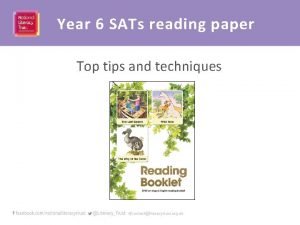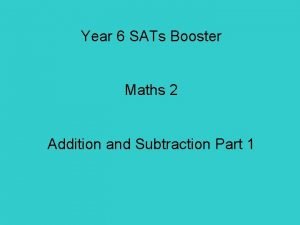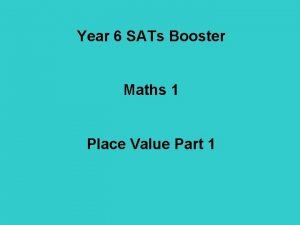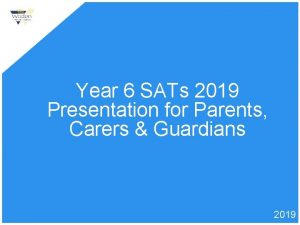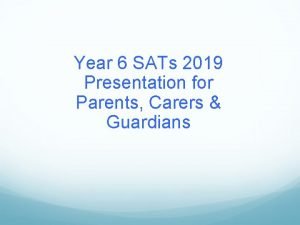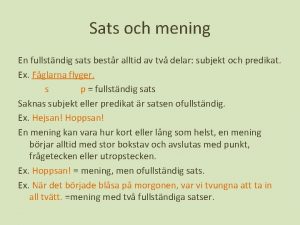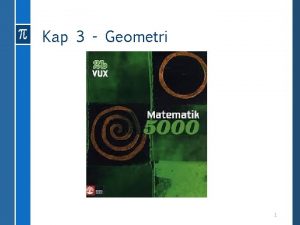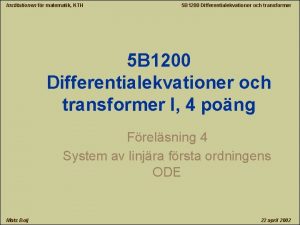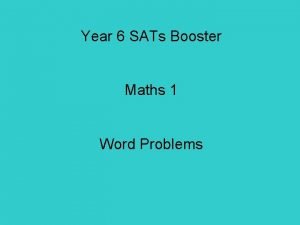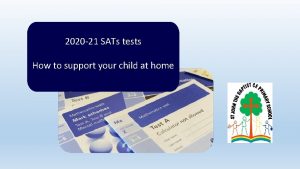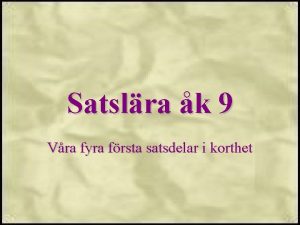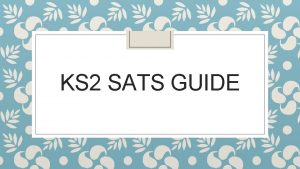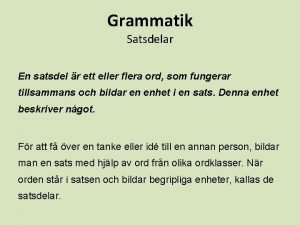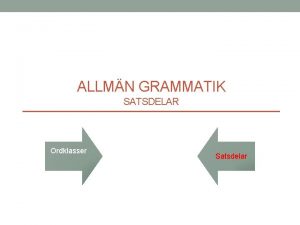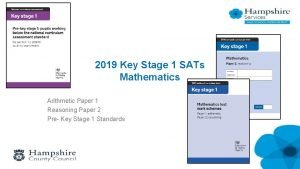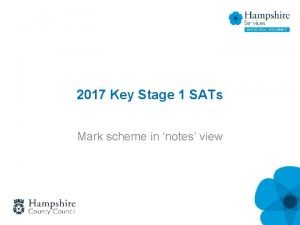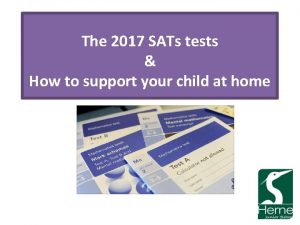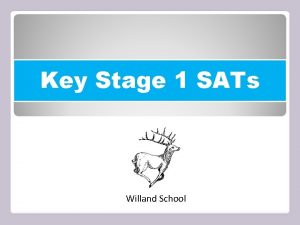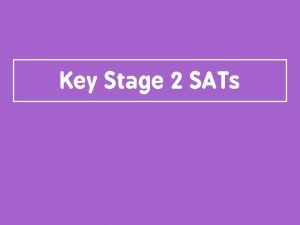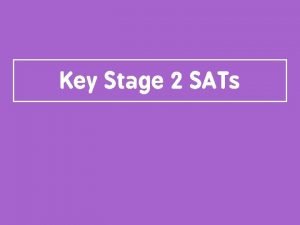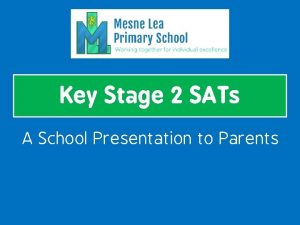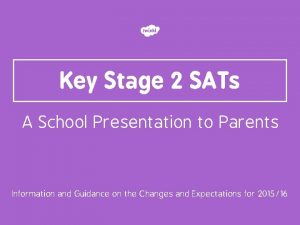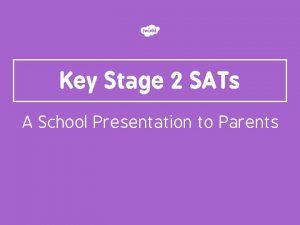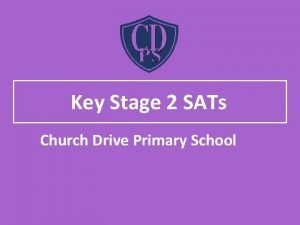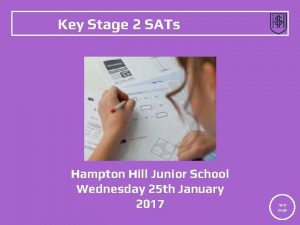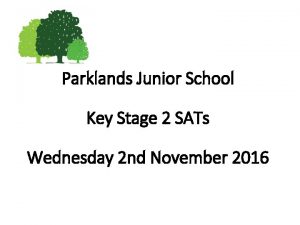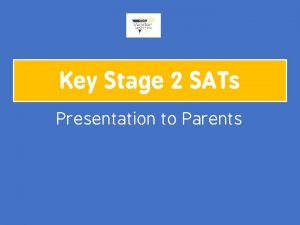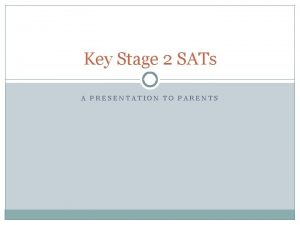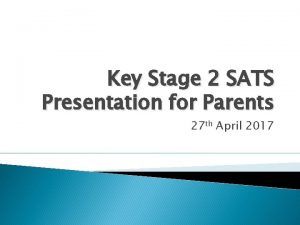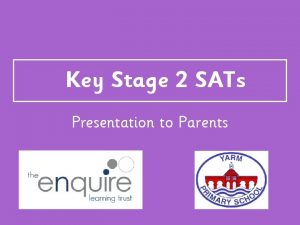Key Stage 2 SATs A School Presentation to



















- Slides: 19

Key Stage 2 SATs A School Presentation to Parents If you have any questions, we would be happy to answer at the end of the presentation. Many Thanks Information and Guidance on the Changes and Expectations for 2017/18

Chapters Key Stage 2 SATs Changes Assessment and Reporting Scaled Scores Scaled Score Examples Higher Attaining Pupils The Tests English Maths How to Help Your Child next page

Assessment and Reporting click to see all text curriculum levelsbeen (e. g. reported Level 3, as 4, 5) have scores’. now been abolished, as set • ‘Old’ Sincenational 2016, test scores have ‘scaled out in the government guidelines. • Your child will still be taught with the highest expectations and cover all required • elements From 2016, scores will be reported as ‘scaled scores’. of test the curriculum. means it is veryisdifficult to compare assessment of a previous with the • This The new curriculum more rigorous andthe sets high expectations which year all schools current year. have had to work hard to meet since it was introduced. • Your child will still be taught with the highest expectations and cover all required elements of the curriculum, similar to previous years. • The new curriculum is more rigorous and sets high expectations which all schools have had to work hard to meet since the beginning of last year. chapter menu next page

Scaled Scores click to see all text • What is meant by ‘scaled scores’? • It is planned that 100 will always represent the ‘national standard’. • Each pupil’s raw test score will therefore be converted into a score on the scale, either at, above or below 100. • The scale will have a lower end point somewhere below 100 and an upper end point above 100. • A child who achieves the ‘national standard’ (a score of 100) will be judged to have demonstrated sufficient knowledge in the areas assessed by the tests. • Each In Julypupil 2016 will forreceive: the first publication of test results, each pupil will receive: o A raw score (number of raw marks awarded). o A scaled score in each tested subject. o Confirmation of whether or not they attained the national standard. chapter menu next page

Scaled Score Examples click to see all text On publication of the test results in July 2016: 2018: • A child awarded a scaled score of 100 is judged to have met the ‘national standard’ in the area judged by the test. • A child awarded a scaled score of more than 100 is judged to have exceeded the national standard and demonstrated a higher than expected knowledge of the curriculum for their age. • A child awarded a scaled score of less than 100 is judged to have not yet met the national standard and performed below expectation for their age. chapter menu next page

click to see all text The Tests • Key Stage 2 SATs take place nationally in the week commencing 14 th 9 th May 2016. 2018. • Statutory tests will be administered in the following subjects: o Punctuation, Reading (60 minutes) Vocabulary and Grammar (45 minutes) o Spelling (approximately 15 minutes) o Reading Punctuation, (60 minutes) Vocabulary and Grammar (45 minutes) o Mathematics - Paper 1: Arithmetic (30 minutes) - Paper 2: Reasoning (40 minutes) - Paper 3: Reasoning (40 minutes) • In addition, some schools will be required to take part in Science testing, consisting of three tests in Biology, Physics and Chemistry. Not all schools will take part in this sampling, which takes place on a later date. • All tests are externally marked. • Writing will be ‘Teacher Assessed’ internally, as in recent years. chapter menu next page

Spelling, Punctuation and Grammar click to see all text • A Spelling test is administered containing 20 words, lasting approximately 15 minutes. • A separate test is given on Punctuation, Vocabulary and Grammar • This test lasts for 45 minutes and requires short answer questions, including some multiple choice. • Marks for these two tests are added together to give a total for Spelling, Punctuation and Grammar. chapter menu next page

Sample Questions Grammar, Punctuation and Spelling Paper 1 chapter menu next page

Sample Questions Grammar, Punctuation and Spelling Paper 1 chapter menu next page

Reading click to see all text • The Reading Test consists of a single test paper with three unrelated reading texts. • Children are given 60 minutes in total, which includes reading the texts and answering the questions. • A total of 50 marks are available. • Questions are designed to assess the comprehension and understanding of a child’s reading. • Some questions are multiple choice or selected response, others require short answers and some require an extended response or explanation. chapter menu next page

Mathematics click to see all text • The Mathematics tests have undergone the biggest change this year. • Children will sit three mathematic tests: Paper 1, Paper 2 and Paper 3. • Children will sit three tests: Paper 1, Paper 2 and Paper 3. • Paper 1 is for ‘Arithmetic’ lasting for 30 minutes, covering calculation methods for all operations, • Paper 1 isincluding for ‘Arithmetic’ use oflasting fractions, for percentages 30 minutes, covering and decimals. calculation methods for all operations, including use of fractions, percentages and decimals. • Questions gradually increase in difficulty. Not all children will be expected to access some • Questions of the more gradually difficult increase questions in difficulty. later in Not the paper. all children will be expected to access some of the more difficult questions later in the paper. • Papers 2 and 3 cover ‘Problem Solving and Reasoning’, each lasting for 40 minutes. • Pupils will still require calculation skills but will need to answer questions in context and • Pupils decide willwhat still require is required calculation to find askills solution. but will need to answer questions in context and decide what is required to find a solution. chapter menu next page

Sample Questions Maths Paper 1: Arithmetic chapter menu next page

Sample Questions Maths Paper 2 / Paper 3 : Reasoning chapter menu next page

Sample Questions Maths Paper 2 / Paper 3 : Reasoning chapter menu next page

How to Help Your Child click to see all text • First and foremost, support and reassure your child that there is nothing to worry about and they should always just try their best. Praise and encourage! • Ensure your child has the best possible attendance at school • Support your child with any homework tasks. • Reading, Ensure your child and is reading at least minutes every and good you are completing spelling arithmetic (e. g. 20 times tables) areday always to practise. their reading journal. • Talk to your child about what they have learnt at school and what book(s) they are • Test your child on their the spellings every day. reading (the character, plot, their opinion). • Arithmetic tables) are always good to practise. Make sure (e. g. your times child has a good sleep and healthy breakfast every morning! • Talk to your child about what they have learnt at school and what book(s) they are reading (the character, the plot, their opinion). • Make sure your child has a good sleep and healthy breakfast every morning! chapter menu next page

click to see all text How to Help Your Child with Reading • Listening to your child read can take many forms. • First and foremost, focus developing an enjoyment and love of reading. • Enjoy stories together – reading stories to your child at KS 1 and KS 2 is equally as important as listening to your child read. • Read a little at a time but often, rather than rarely but for long periods of time! • Talk about the story before, during and afterwards – discuss the plot, the characters, their feelings and actions, how it makes you feel, predict what will happen and encourage your child to have their own opinions. • Look up definitions of words together – you could use a dictionary, the internet or an app on a phone or tablet. • All reading is valuable – it doesn’t have to be just stories. Reading can involve anything chapter from fiction and non-fiction, poetry, newspapers, magazines, football programmes, TVmenu guides. • Visit the local library - it’s free! next page

How to Help Your Child with Writing click to see all text • Practise and learn weekly spelling lists – make it fun! • Encourage opportunities for writing such as letters to family or friends, shopping lists, notes or reminders, stories or poems. • Write together – be a good role model for writing. • Encourage use of a dictionary to check spelling and a thesaurus to find synonyms vocabulary and expand vocabulary. • Allow your child to use a computer for word processing, which will allow for editing and correcting of errors without lots of crossing out. • Remember that good readers become good writers! Identify good writing features when reading (e. g. vocabulary, sentence structure, punctuation). • Show your appreciation: praise and encourage, even for small successes! chapter menu next page

How to Help Your Child with Maths click to see all text • Play times tables games • Play mental maths games including counting in different amounts, forwards and backwards. • Encourage opportunities for telling the time • Encourage opportunities for counting coins and money; finding amounts or calculating change when shopping • Look for numbers on street signs, car registrations and anywhere else! • Look for examples of 2 D and 3 D shapes around the home • Identify, weigh or measure quantities and amounts in the kitchen or in recipes • Play games involving numbers or logic, such as dominoes, card games, darts, draughts or chess chapter menu next page

Any Questions?
 Year 6 tips
Year 6 tips Sats booster maths
Sats booster maths Sats booster maths
Sats booster maths Year 6 sats papers 2019
Year 6 sats papers 2019 Year 6 sats 2019
Year 6 sats 2019 Sats week
Sats week Aktiv form exempel
Aktiv form exempel Steiners sats
Steiners sats Randvinklar och medelpunktsvinklar
Randvinklar och medelpunktsvinklar Sats transformer
Sats transformer Zids and zods answers
Zids and zods answers Year 6 sats revision timetable
Year 6 sats revision timetable Sats tests 2020
Sats tests 2020 Ofullständig sats
Ofullständig sats What are sats
What are sats Vad är direkt objekt
Vad är direkt objekt Bisats och huvudsats
Bisats och huvudsats Sats papers 2019
Sats papers 2019 2017 sats mark scheme
2017 sats mark scheme Sats 2017 reading paper
Sats 2017 reading paper
